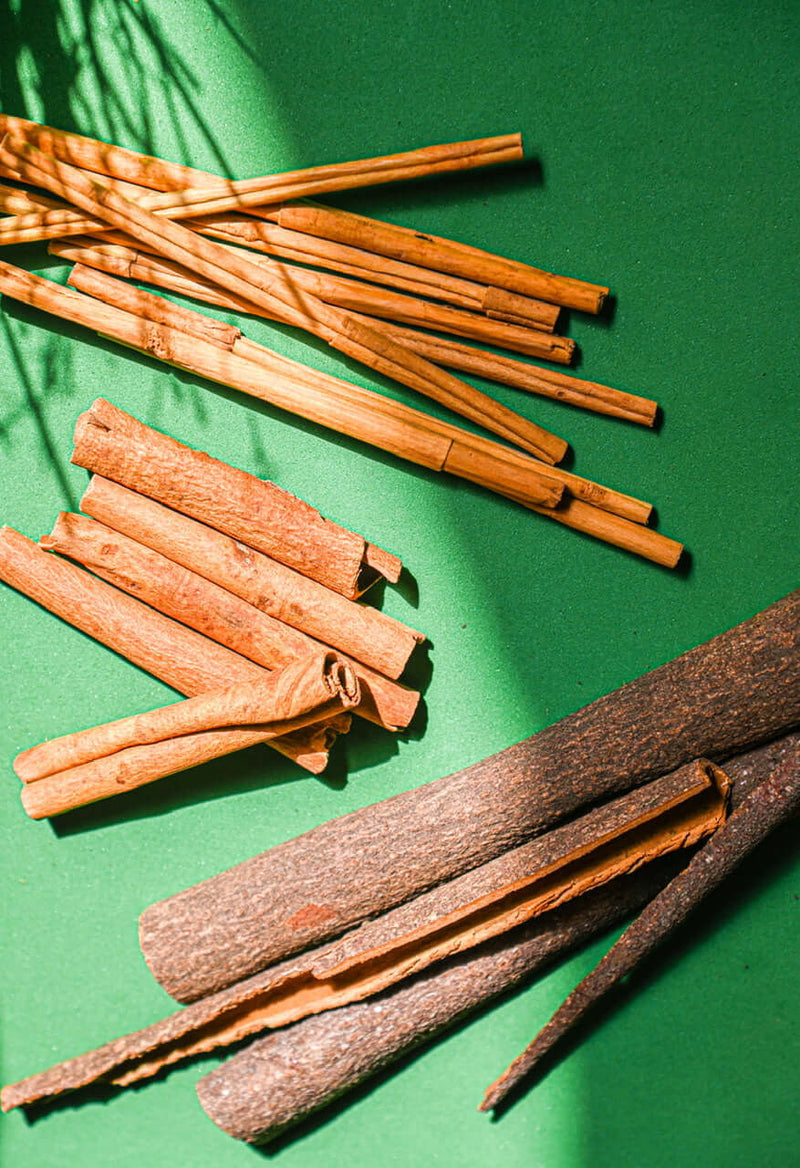Empires fought wars to possess this sophisticated spice, however, True Cinnamon still remains elusive to most of us today.
We want you to know more about the cinnamon that sits on your cinnamon buns, apple pies or blended amongst the myriad of spices in ‘Garam Masala’. Over 90% of the cinnamon that you find on the retail shelves are of the species ‘Cassia’ and less than 10% of which are ‘True Cinnamon’. True Cinnamon (Cinnamomum Verum) is indigenous to Sri Lanka, whereas Cassia ~ a common name for a related species ~ has many origins - China (Cinnamomum cassia), Indonesia (Cinnamomum burmannii) & Vietnam (Cinnamomum loureiroi). Several Cinnamomum species’ barks are generally labeled as cinnamon, although only Cinnamomum Verum carries the common name of True Cinnamon.
The two differs in species & therefore in taste, texture and quality. The taste of True Cinnamon is subtle yet sweet, unlike that of Cassia which is stronger, spicier and slightly bitter.
Cassia’s potency makes it the go-to variety for global cinnamon connoisseurs and home-bakers alike. This less-expensive cinnamon substitute has been marketed as simply ‘Cinnamon’ over the years, often without specification of the origin or the species.
Why should you care! Cassia too tastes like Cinnamon you would ask? Well, a little bit of patience is what we ask of you.
Cinnamon consists of a blood-thinning chemical component called ‘Coumarin’ that is known to be moderately toxic to the liver and is banned by the FDA as a food additive but unregulated in naturally occurring form.
“Cassia cinnamon contains up to 1% coumarin, whereas true cinnamon contains only a trace, about 0.004%”
(Link: https://tinyurl.com/CzechRepublic-coumarin)
The analysis of certain cinnamon-containing food products in Czech Republic had revealed that a child could exceed the maximum daily coumarin intake with just three or four “cinnamon star cookies” that are made using the Cassia variety.
Samples from the True Cinnamon, however, had negligible levels of coumarin, often below the limits of detection.
The German Federal Institute for Risk Assessment (BFR) amplifies the need to use True Cinnamon over Cassia for the health benefits over the latter.
(Link: https://www.bfr.bund.de/cm/349/faq-on-coumarin-in-cinnamon-and-other-foods.pdf).
“Consumers who frequently use large amounts of cinnamon as spice in their home cooking, for example, for rice pudding with sugar and cinnamon, should use Ceylon cinnamon (True Cinnamon) which contains low levels of coumarin.” ~ BFR
By now you should be able to discern True Cinnamon from Cassia in terms of its taste and the very fact that they originate from entirely different species. But how do you distinguish the two in terms of their appearance?
True cinnamon is indigenous to Sri Lanka (formerly known as Ceylon) and the pride of Sri Lankans. The hand-crafted process of scraping, peeling & rolling the naturally-dried inner barks of the Cinnamomum Verum tree is perfected for generations by highly-skilled cinnamon peelers and is known to none outside of the island nation. The light tan-coloured bark are peeled and intricately-folded into paper-thin layers with deft hands, thus resembling a cigar.
True Cinnamon quills consists of intricately hand filled multiple layers of smaller pieces of the same inner bark called quillings. Cassia sticks, on the other hand, are simply the bark cut into pieces and when dried, it curls up naturally to form a hollow in the centre. True cinnamon quills are brittle & delicate, whereas, cassia sticks are thick & hard. Ground cassia has a reddish brown colour, while True Cinnamon has a light tan hue.
At Food of Gods, we source the finest quality of True Cinnamon, organically grown in a mountainous village that shares its borders with natural forest land & natural springs, unlike plantations where cinnamon trees are grown using chemical fertilisers, and then sulphur treated to hide its natural imperfections.
Our quills are made from carefully selected barks that are harvested before dawn, the outer barks are thoroughly scraped & the inner barks are loosened & then skilfully peeled to form the finest of quills that are delicate & brittle, floral & aromatic.
Experience and indulge in the finest Kandy Heirloom Cinnamon.

